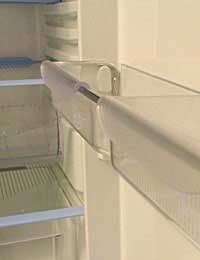
Save energy by utilising your fridge more efficiently. You could slash your energy bills by acting on a few key tips – here’s our guide.
The Importance of Using Your Fridge Efficiently
Because it’s always on, your fridge is one of the home’s biggest energy consumers. Back in the 1970s, fridges were expected to consume around 2000kW per year – but today’s models average around 350kW (80% less!). Progress has been remarkable, so if your fridge is more than 5 years old, it would be worth considering a replacement model – read our article about choosing a new one first.
Using Your Fridge Efficiently
Many modern kitchens are not designed with energy efficiency in mind. Disguising your fridge behind a door or putting it under a worktop do not give the fridge sufficient ventilation, and should really be avoided if possible. If you do have the choice of where to site your new fridge (for instance if you’re redesigning the whole kitchen), try to pick a place that’s out of direct sunlight and well away from hot appliances like kettles and ovens. This isn’t always possible, but it will help.
The fridge expels hot air produced by its motor through the coils at the back of the machine. It’s very important to allow a little space for the coils to release heat, and you can also improve their efficiency by pulling out the fridge and dusting the back once a year.
At the same time (or preferably more often), defrost your fridge to remove frosty build-up and give it a good clean-out.
Keep your fridge full, but not stuffed. The shelves need space for air ventilation, which helps the fridge to maintain an even temperature. Keep foods like chocolate, potatoes, courgettes and peppers, and oil-preserved jars in storage at room temperature – the fridge temperature does nothing for them.
Moisture in the fridge makes the motor work harder to chill and prevent ice. That’s why it is so important to cool foods before you put them in the fridge. Wrapping them tightly also prevents moisture from escaping during storage.
Efficient Storage For Your Fridge
It’s worth investing in a set of good storage containers for your fridge. You can buy mats (Lakeland supplies these) for the vegetable drawers, designed to prolong the life of fresh veg and salad. Further up, you will need a couple of boxes for uncooked meat, which should be kept separate from fresh goods. If you have an ice-maker or egg rack on the fridge door, remove them – the energy-hungry ice-maker is worse than an ice cube tray in the freezer, and the door is the worst place to keep fresh eggs.
Leftovers are often stored in the fridge. These should first be thoroughly cooled, then wrapped and tightly sealed. Tinned foods should not be kept in their tins in the fridge – no, not even if they’re covered. Transfer the beans or other food to a clean container before refrigerating. Finally, make sure that there is space for air to circulate around all of the shelves, which helps the motor to maintain a steady temperature.
